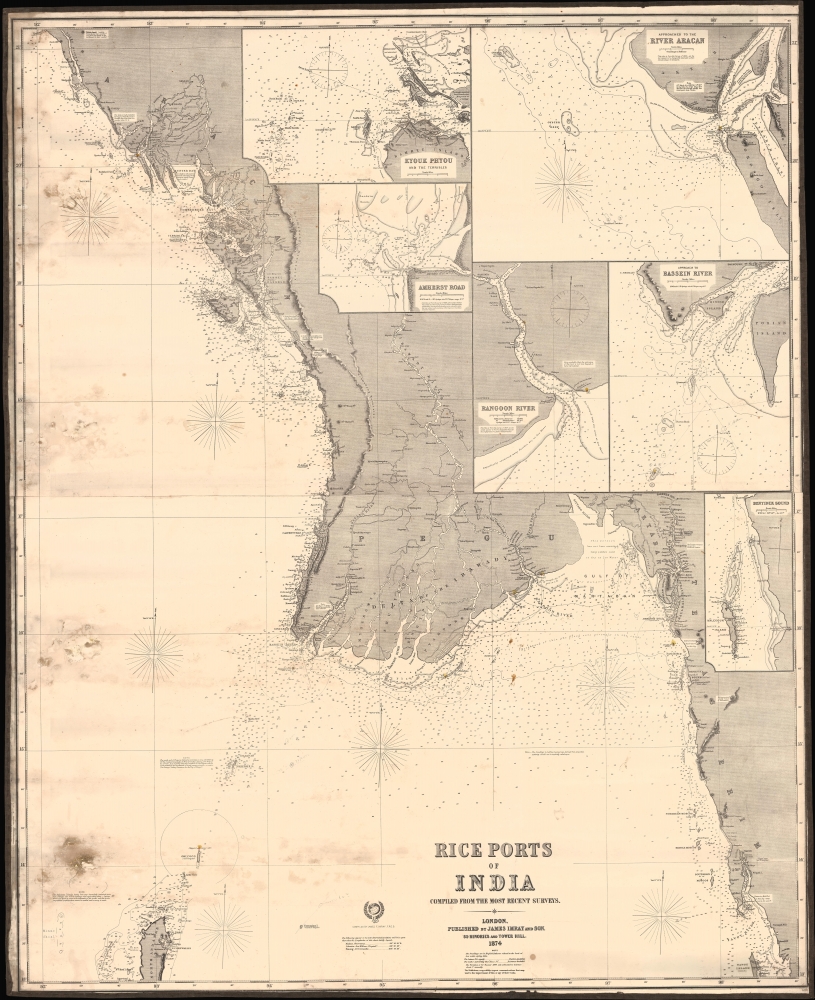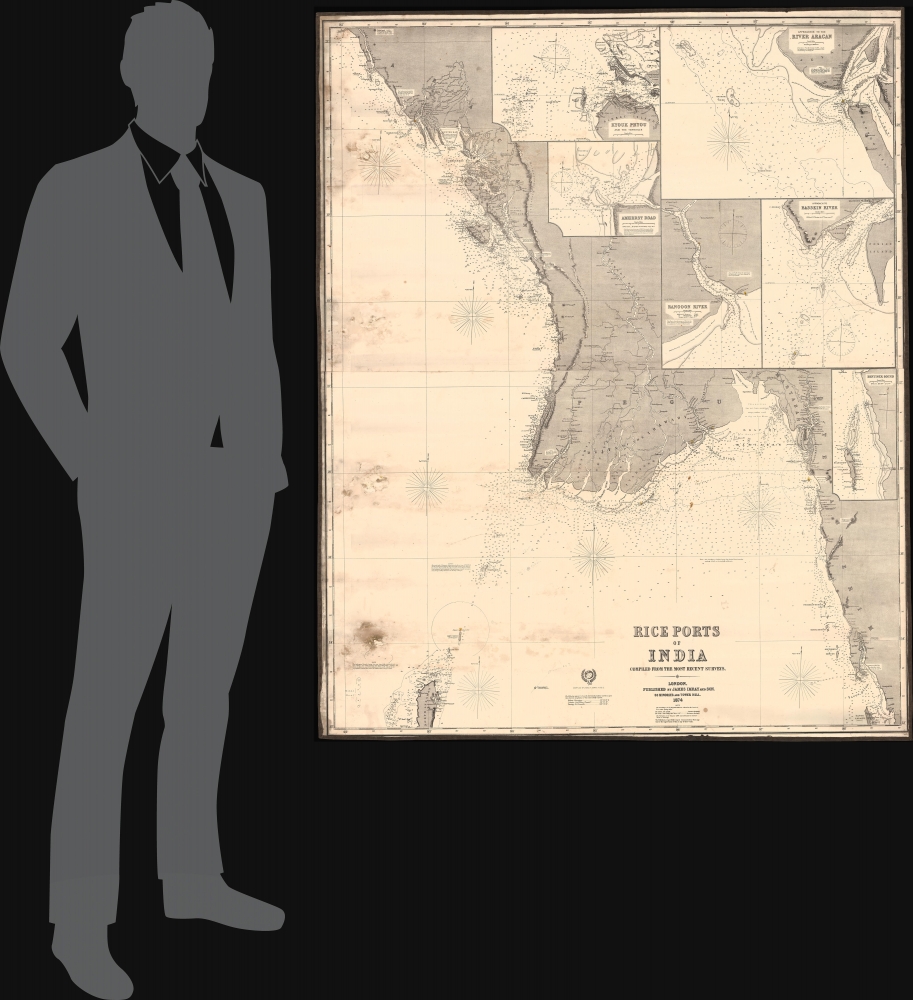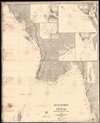1874 Imray Nautical Map of Rice Ports of India / Burma / Myanmar
RicePortsIndiaBurma-imray-1874
Title
1874 (dated) 50.5 x 41.25 in (128.27 x 104.775 cm) 1 : 730000
Description
A Closer Look
The chart covers the Irrawaddy Delta and the Gulf of Martaban as far south as Tavoy Island (Mali Kyun) and as far west as the northern Andaman Islands. The following description of the chart was published by Rosser and Imray in the Catalog section of their 1867 Seaman's Guide to the Navigation of the Indian Ocean and China Sea,A chart on two large sheets of the coasts of the Bay of Bengal between latitudes 13° and 21° N, longitudes 92° and 98° E. With plans of Akyab, Kyou, Phiouk, Bassein River, Rangoon River, Maulmain, and Kalegouk Island anchorage. A very useful chart for Shipmasters bound to Akyab, Rangoon, or Maulmain as it exhibits the navigation on a larger scale than any hitherto published.
Rice Production in Burma
The Irrawaddy-Sittang Delta offers near-ideal conditions for rice production. The earliest reports of major rice exports date to the 16th century when it was exported in volume to Malaya. Nonetheless, by the 18th century, the Delta region was nearly depopulated due to a series of failed Mon uprisings against the Burmese Emperors and retaliatory genocide. The Burmese Emperors also restricted rice exports. In 1853, following the Second Anglo-Burmese War (1853 - 1853), the British seized lower Burma. They found themselves in control of a vast jungle with few resources. With an eye to profit, British engineers began leveraging labor from India to convert the jungle to rice paddies. They also pressured Emperor Mindon Min (1808 - 1878), based in Mandalay, to sign a treaty allowing open immigration to British-controlled territory. The result was a vast wave of immigration wherein 30,000 - 40,000 people per year migrated to British Burma to settle and work the rice fields. In 1852, there were roughly 900,000 acres of padi land in Lower Burma; by 1874, when this map was issued, there were 2,000,000, and by 1900, there were 6,000,000. The increased rice production in Burma was so significant that it impacted global food consumption and gastronomy. Where rice was once a luxury, it became a staple - a fact compounded in Europe and America by the opening of the Suez Canal.Blueback Charts
Blueback nautical charts began appearing in London in the late 18th century. Bluebacks, as they came to be called, were privately published large-format nautical charts known for their distinctive blue paper backing. The backing, a commonly available blue manila paper traditionally used by publishers to wrap unbound pamphlets, was adopted as a practical way to reinforce the low-quality paper used by private chart publishers in an effort to cut costs. That being said, not all blueback charts are literally backed with blue paper. The earliest known blueback charts include a 1760 chart issued by Mount and Page and a 1787 chart issued by Robert Sayer. The tradition took off in the early 19th century, when British publishers like John Hamilton Moore, Robert Blachford, James Imray, William Heather, John William Norie, Charles Wilson, David Steel, R. H. Laurie, and John Hobbs, among others, rose to dominate the chart trade. Bluebacks became so popular that the convention was embraced by chartmakers outside of England, including Americans Edmund March Blunt and George Eldridge, as well as Scandinavian, French, German, Russian, and Spanish chartmakers. Blueback charts remained popular until the late 19th century when government-subsidized organizations like the British Admiralty Hydrographic Office and the United States Coast Survey began issuing their own superior charts on high-quality paper that did not require reinforcement.Publication History and Census
This map was published by James Imray and Son in 1874. We note editions of this chart as early as 1866 and as late as 1924, but most are dated 1872 or 1874, as here. The OCLC notes examples at the British Library and the National Library of Australia. We are aware of at least 3 examples in private collections.Cartographer
James Imray (May 16, 1803 - November 15, 1870) was a Scottish hydrographer and stationer active in London during the middle to latter part of the 19th century. Imray is best known as a the largest and most prominent producer of blue-back charts, a kind of nautical chart popular from about 1750 to 1920 and named for its distinctive blue paper backing (although not all charts that may be called "blue-backs" actually have a blue backing). Unlike government charts issued by the British Admiralty, U.S. Coast Survey, and other similar organizations, Imray's charts were a private profit based venture and not generally the result of unique survey work. Rather, Imray's charts were judicious and beautiful composites based upon pre-existing charts (some dating to the 17th century) and new information gleaned from governmental as well as commercial pilots and navigators. Imray was born in Spitalfields, England, the eldest son of a Jacobite dyer also named James. Imray did not follow his father profession, instead apprenticing to William Lukyn, a stationer. He established himself as a bookseller and bookbinder at 116 Minories Street, where he shared offices with the nautical chart publisher Robert Blanchford. In 1836 Imray signed on as a full partner in Blanchford's enterprise, christening themselves Blanchford & Imray. At this time the Blanchford firm lagged far behind competing chart publishers Norie and Laruie, nevertheless, with the injection of Imray's marketing savvy the firm began a long rise. James Imray bought out Blanchford's share in 1846, becoming the sole proprietor of the chart house, publishing under the imprint of James Imray. Relocating in 1850 to larger offices at 102 Minories, Imray was well on track to become the most prominent chart publisher in London. In 1854, when Imray's 25 year old son, James Frederick Imray, joined as a full partner, the firm again changed its imprint, this time to James Imray and Son. The elder Imray was a master of marketing and was quick to respond to trade shifts and historic events. Many of his most successful charts were targeted to specific trade routes, for example, he issued charts entitled "Cotton Ports of Georgia" and "Rice Ports of India". Other charts emerged quickly following such events as the 1849 California Gold Rush. Imray's rise also coincided with the development of governmental mapping organizations such as the Admiralty and the U.S. Coast Survey, whose work he appropriated and rebranded in practical format familiar to navigators. Imray's death in 1870 marked a major transition in the firm's output and began its decline. Though Imray's son, James Frederick, excelled at authoring pilot books he had little experience with charts and issued few new publications. Most James Frederick Imray publications issued from 1870 to 1899 were either revisions of earlier maps prepared by his father or copies of British Admiralty charts. Charts from this period are recognizable as being less decorative than the elder Imray's charts following the stylistic conventions established by the Admiralty. The Admiralty itself at the same time began to rise in prominence, issuing its own official charts that were both cheaper and more up to date than those offered by private enterprises. By the end of the century the firm was well in decline and, in 1899 "James Imray and Son" amalgamated with the similarly suffering "Norie and Wilson", which was itself acquired by Laurie in 1904. Today it continues to publish maritime charts as "Imray, Laurie, Norie and Wilson". More by this mapmaker...




